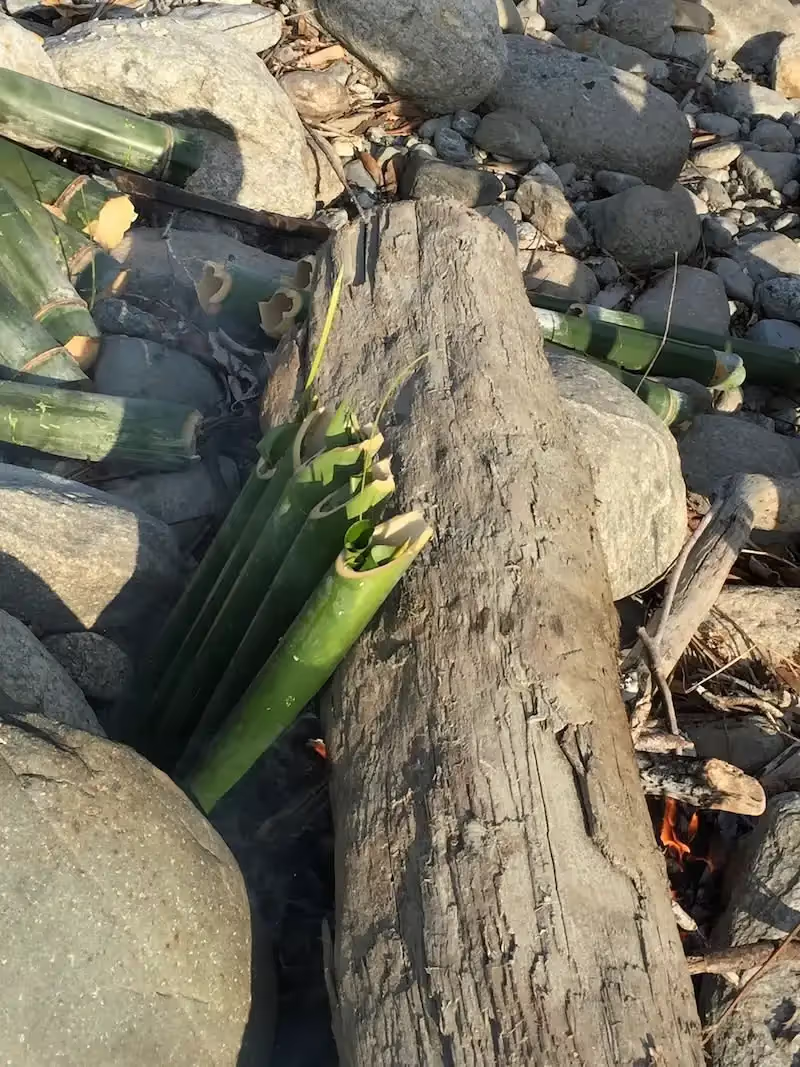There’s something undeniably magical about eating in the wild. The scent of smoke curling through thick jungle air, the crackle of a bamboo tube over an open fire, and the anticipation of a traditional Borneo jungle feast are enough to stir even the most seasoned traveller. But what if we told you that one of the most flavourful dishes in the rainforests of Borneo isn't served in restaurants—it's crafted by the Iban tribe, deep in the jungle, using nothing more than bamboo, fresh herbs, and ancient knowledge?
Welcome to the world of bamboo chicken, a signature dish of the Iban tribe of Sarawak, Malaysia, where cooking is as much about culture and survival as it is about taste.

The Jungle Feast Begins
In the heart of Borneo’s rainforest, the Iban people still rely on traditional cooking methods, especially during festivals, gatherings, or jungle treks. Known for their close relationship with nature, the Iban tribe turned to the forest for ingredients and cooking tools.
Bamboo chicken (or manok pansuh) is a prime example of this age-old tradition. The chicken is marinated with wild herbs like lemongrass, ginger, torch ginger flower, and bunga kantan, then stuffed into a green bamboo stalk. It’s then sealed with banana leaves and slowly roasted over an open fire.
The result? A tender, juicy, and aromatic dish that absorbs the earthy scent of bamboo and the smoky flavour of the jungle.
What Makes Bamboo Chicken So Special?
This traditional bamboo cooking method is more than just a culinary technique—it reflects the Iban tribe's food culture. Without pans or pots, the Iban use nature to the fullest. Bamboo tubes act as both cooking vessels and flavour infusers.
As the chicken stews in its juices, the bamboo gradually chars on the outside, adding a subtle smokiness to the meat. The natural pressure inside the stalk ensures even cooking, similar to a pressure cooker. It’s eco-friendly, efficient, and requires no metal cookware. Talk about sustainable cooking methods long before the term became trendy!

The Origins: A Legacy in the Leaves
The dish is often prepared during the Gawai Dayak festival, a harvest celebration among the Dayak people of Borneo. Families gather around fires, each preparing their version of bamboo chicken, often alongside rice cooked in bamboo and wild jungle vegetables.
During these festivals, one truly experiences the warmth of indigenous food tourism. Visitors are often invited to join, cook, and eat with the tribe, making it less of a meal and more of a memory.

Tribal Cooking Methods in a Modern World
In a time where modern appliances dominate kitchens, off-grid cooking techniques like these offer a fascinating look into the past. Some eco-lodges and rural homestays in Sarawak now offer cooking classes, teaching travellers how to make bamboo chicken traditionally.
As interest in ethnographic cuisine experiences grows, more foodies seek authentic dishes from indigenous communities. This not only supports local tribes, but it also preserves ancestral food traditions.
How to Try Bamboo Chicken for Yourself
If you’re visiting Malaysia or Borneo, look out for cultural tours offering jungle trekking with Iban guides. Many include meals cooked in the wild. Alternatively, head to a longhouse village in Sarawak, where families often welcome guests to experience traditional cooking.
If you’re adventurous in your kitchen, you can try a simplified version using an oven-safe container and plenty of banana leaves, though nothing truly compares to the real thing cooked in bamboo over jungle flames.
Final Bite
The secret of Borneo’s jungle feast isn’t just about what’s on your plate. It’s in the hands that prepare it, the stories shared around the fire, and the deep respect for nature embedded in every bite. Bamboo chicken is more than a dish; it’s a legacy of the Iban tribe and their deep culinary roots.
So the next time you find yourself near the rainforests of Borneo, follow the smoke. You might discover the unforgettable taste of the jungle—served in a bamboo tube, and seasoned with centuries of tradition.
FAQs
1. Will we be able to have bamboo chicken in our travel plan
We always try and put some flavours of local traditions , culture and food in our itineraries. Depending on the region you travel to, local traditional cooking may form a part of the experiences.
2. Why do the Iban cook in bamboo?
Bamboo naturally steams the food and adds flavour—no pots or pans needed. In the jungle all the ingredients are easily available as well.
3. Is Borneo a safe place to travel?
Yes, Borneo is a considered a safe place for tourists. Malaysia part of it falls on the main tourist route. Indonesia side of it still has many unexplored and less travelled to parts. Either way people there are very friendly towards tourists.
4. What ingredients are used in bamboo chicken?
Chicken, lemongrass, ginger, garlic, torch ginger, and jungle herbs.

